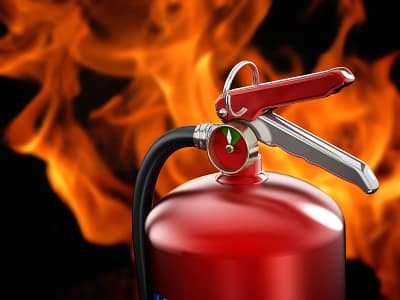
Fighting Fires
Fire extinguishers come in three varieties based on the material that is fueling the fire.
- Type A: Type A extinguishers are used for putting out fires fueled by wood, cloth, paper, rubber, and plastics. This is most likely the kind you would see in an office environment, and therefore must be within 75 feet of employees performing any work task.
- Type B: Type B extinguishers take on fires ignited by flammable liquids such as gasoline, kerosene, oil paint, or kitchen grease. Employees should be no farther than 50 feet away from this fire extinguisher.
- Type C: Type C extinguishers tackle electrical fires.
Using any of these varieties is extremely straightforward: pull the locking pin off, aim at the base of the flames, and squeeze the handle while sweeping it over all the areas that are burning.
Despite the simplicity of these instructions, facing fire can be terrifying; it isn’t uncommon for people to freeze or panic rather than take action, even when there are only three steps involved. That is why it is absolutely vital that employees be given the opportunity to take fire extinguisher training courses — the divide between some damaged property and a lost life is as big and deep as the Grand Canyon, but can easily be crossed if no one intervenes.
That being said, some fires shouldn’t be fought by employees that have only taken one or two fire extinguisher training courses; in addition to teaching you how to wield the life- and property-saving tool, you’ll also be informed on when to leave it to the professionals. Since many fire extinguisher classes go hand-in-hand with first aid training or CPR classes, you’ll be able to learn everything you may need (such as how to improve survival by 93% through the use of an onsite AED, or automatic external defibrillator) in an emergency situation, whether it happens at work or during your lunch break. In short, it always pays to be prepared.
Get prepared with OSHA Certified Fire Extinguisher Training
Portland, Oregon and Vancouver, Washington



